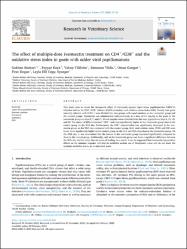The effect of multiple-dose ivermectin treatment on CD4+/CD8+and the oxidative stress index in goats with udder viral papillomatosis

Göster/
Erişim
info:eu-repo/semantics/embargoedAccessTarih
2023Yazar
Bozkurt, GökhanKaya, Feyyaz
Yıldırım, Yakup
Yıldız, Ramazan
Güngör, Orsan
Doğan, Fırat
Ayözger, Leyla Elif Özgü
Üst veri
Tüm öğe kaydını gösterÖzet
This study aims to reveal the therapeutic effect of ivermectin against Capra hircus papillomavirus (ChPV-1)
infection and on the CD4+/CD8+ (cluster of differentiation) and oxidative stress index (OSI). Twenty hair goats
naturally infected with ChPV-1 were divided into two groups with equal numbers as the ivermectin group and
the control groups. Ivermectin was administered subcutaneously at a dose of 0.2 mg/kg to the goats in the
ivermectin group on days 0, 7, and 21. Blood samples were collected from the vena jugularis on days 0, 21, 45,
and 90. The cluster of differentiation4+/CD8+ ratio was significantly higher in the ivermectin group than in the
control group on the 90th day. Furthermore, the CD8+ concentration was significantly decreased in the ivermectin group on the 90th day compared with the control group. Both total oxidant status (TOS) and OSI were
found to be significantly higher in the control group on the 21st and 45th days than in the ivermectin group. On
the 90th day, it was determined that the lesions in the ivermectin group improved significantly compared to
those in the control group. Additionally, only in the ivermectin group was there a significant difference between
the 90th day and the other days in terms of healing. As a result, it can be suggested that ivermectin has positive
effects on the immune response and that its oxidative actions are of therapeutic value and do not harm the
systemic oxidative status, as in untreated goats.

















